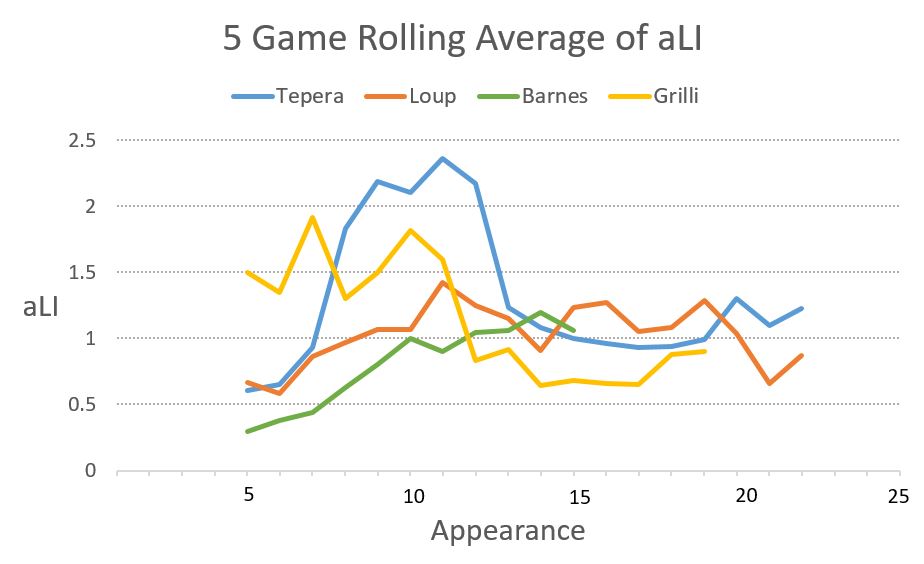Most of the conversation that’s surrounded the Blue Jays to this point has been about all the things that have gone wrong. The high profile injuries, the lackluster depth among starting pitchers, the lackluster depth at catcher, the poor start that’s rendered the rest of the season an uphill climb, overall offensive woes and so on and so forth. That’s not to say that those stories have been unfair – this season has been slow to get off the ground and any playoff hopes are counting on a nice little run before the calendar turns to July. But in all of that there have been a handful of positives including the turnarounds of Kevin Pillar and Justin Smoak and the ascent of Joe Biagini.
One of the best untold stories of the year, however, has been the reformation of the Toronto bullpen, led by three homegrown talents that have exceeded all expectations to this point. At one point or another, all three have earned their way into higher leverage work, making their ways up from the bullpen’s less glamorous roles.
Danny Barnes
Back in 2010, the Jays selected Danny Barnes out of Princeton University in the 35th round of the draft. Barnes, having only made three starts since being drafted, has always boasted strong strikeout numbers working in relief, never posting a K/9 below 9.0 in any stop during his time in the organization. He has also shown excellent command – among stints with more than 10 innings pitched, last season’s 3.29 BB/9 in an abbreviated stay with the big club represents his highest mark since the 6.75 he posted back in A-ball in 2010. As for this season, Barnes made the most of his call-up and appears to have asserted himself as a viable middle reliever. He owns a 2.33 ERA and 1.03 WHIP with 21 strikeouts in 19.1 innings so far this year.
Ryan Tepera
In the 19th round of the 2009 draft, Toronto selected Ryan Tepera out of Sam Houston State. Unlike Barnes, Tepera was a converted starter and only moved to full time relief in AAA. While he’s posted solid strikeout numbers in the majors (7.9 K/9), he’s been far more of a ground ball pitcher throughout his career, generating grounders 46.5 percent of the time. Once used as a mop up man, Tepera has been absolutely terrific this season and leads the team in bullpen innings with 29.1 while delivering a sterling 2.76 ERA and 0.89 WHIP.
Aaron Loup
In that same year, Tulane’s Aaron Loup was chosen in the ninth round and made his Major League debut in 2012, appearing in 33 games. He was the owner of three very strong MLB seasons before completely imploding in 2015 and 2016. He saw some troubling changes, particularly in his HR/FB numbers which jumped from zero, 10.6 and 8.5 in his first three years up to 20.7 and 18.2 in the following seasons. As for balls that stayed in the yard, Loup had some more tough times with BABIP’s of .339 and .342 in his down years – well above the .299 mark that was his previous career-high. Fortunately for the Jays, Loup has settled down quite a bit this season. While he still might get the collar tug going in the stands from time to time, that’s more on his reputation than anything he’s put forth on the mound this year. He owns a 2.37 ERA in 19 innings, having allowed an earned run in just 3 of his 22 appearances and more than one earned run only once.
Every clean outing reinforces the notion that someone deserves high leverage innings, so I charted the Average Leverage Index (aLI) of each reliever’s appearance to see if their workloads have changed in terms of toughness or importance – Leverage Index is simply a measure of importance based on score, inning and baserunner for a given play; a numerical way to look at vital situations in a game. Below is a five game rolling average of aLI so we can get a feel for the changes in John Gibbons’ bullpen pecking order while smoothing over some of those “just to get some work” outings.
I’ve excluded Dominic Leone, Joe Smith and Roberto Osuna from this exercise because their roles have been fairly stable throughout the year. On the other hand, I decided to include Jason Grilli, who was relegated to low-leverage innings to try and work through his issues.

With a few blips, Barnes, Tepera and Loup are all on an upward trend and receiving more important innings than at the beginning of the year. Tepera’s spike was thanks to an 11th inning save with a 4.72 aLI while his swoon was caused by a .01 aLI inning in the final inning of a 6-0 loss. Loup’s usage as a lefty specialist (despite his strong numbers against righties so far) means that he’s often called upon to face a specific batter regardless of game state but it looks as though Gibbons is saving his appearance for more critical situations when possible. Yes, it’s a small sample to this point in the year, but we can still get a sense of the changes in deployment.
As to be expected given the general trend, all three have been handed “High Leverage” (using the Baseball Reference definition of aLI ≥ 1.5) situations more frequently as the season has gone on. It’s clearly evident with Barnes, who has really risen through the ranks after being used as an innings eater or last resort. While rest patterns and the need for regular work sometimes force players into low leverage (aLI ≤ 0.7) spots, the trio is soaking up “easy” innings less often. Here’s the aLI of each appearance by the three pitchers in question plus Grilli broken down into High Leverage, Medium Leverage and low Leverage situations:
Here’s the breakdown in just May:
Again, it’s shown pretty clearly here that Barnes, Tepera and Loup are all working increasingly valuable situations in games, with a few coming at the expense of the bullpen’s resident veteran. With the Blue Jays sitting third in the majors in terms of bullpen innings pitched, these contributions have been incredibly important in keeping the season afloat.
So all three are rising to the top of the middle relief heap, and deservedly so. Last season the team relied on a pair of trades to revamp their bullpen that worked out wonderfully. That was always unlikely to play out again, so any holes in the dam would have to be plugged by improvement from within. Toronto has found three cheap, effective options to manage the middle innings. While much hasn’t gone right in 2017, this is one area where the Jays should be feeling fortunate.
*All numbers are accurate as of Saturday, May 27th
Lead Photo: © Kim Klement-USA TODAY Sports


